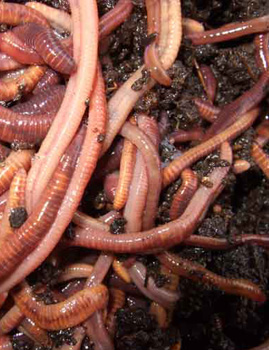www.yanzum.com
 (above photo) "Spring Flowers" garden sculpture created by author from old recycled bed springs. |
|||||
|
Home Page Garden Articles Garden Market Information
|
||||
|
My personal home garden composting story. I've been a gardener in one way or another for most of my life. I remember bringing my first plant home from grade school when I was about 6 or 7. It was an umbrella plant. Even today I have umbrella plants in one of my bogs, although they aren't direct descendants from that one from grade school. I do, however, have a fondness for them because of that original memory. I always had house plants in my apartments wherever I lived, but I didn't have my first vegetable garden until my last apartment, right before I bought my first house in Atlanta's Midtown. That first garden set the trend for even more gardening at the new house because now I actually owned the land which I was tilling and planting in. Now I could get serious about it, so I started experimenting with composting. I raked up leaves from the massive old oak trees that made a canopy over the street in front of my 1913 home on 9th Street. Instead of putting them in bags for the city to haul away like everyone else, I made a big pile of them out back where they could slowly rot and allow the worms to enjoy a feast. I did this with all my yard waste because I instinctively knew it would all pay off one day, plus I was born with this innate need to never throw anything away that could be used elsewhere. I used to joke that I must have lived through the Great Depression in a previous life, but I honestly don't know where it comes from. I often feel I'm the only one who is this way. It can feel like a blessing or a curse, depending on what's going on that day. I soon learned that the compost deterioration process worked faster if I occasionally added water and turned the contents over with a pitch fork, allowing air to get inside. One day I was startled when I pulled the pitch fork out and realized I had accidentally impaled a harmless garden snake that must have been snoozing under cover of the leaves. I felt horrible. Working composts generate a lot of heat, so the poor cold blooded snake was just trying to stay warm during the winter chill. I've always been a little creeped out by snakes, but I know they are very beneficial, especially in a garden, so I would never intentionally kill a harmless one. One afternoon I had some friends over for a party when one of them came to me with an apple core, asking where I kept my organic waste jar. It was one of those “aha moments” when I realized I wasn't the only one doing these strange things. It suddenly made me feel part of a secret society of people who care about how we treat our planet. That was probably 20 some years ago ….now fast forward to 2009. I think the time has come when we all must become part of that “secret society” so we can rescue our planet earth from our long time bad habits and negligence. How I made my Compost I moved here on April Fools Day 2001 to this small Florida beach town, with a new home and a new garden to create. One of the first things I did was to buy a small roll of cheap metal fencing. I cut a piece to create a circle about 4 feet in diameter. I used the loose ends of each horizontal wire to connect the two ends together, using a simple bend over the adjoining wire so it could be easily removed later. This was for my new compost pile. The 4 foot high wire fencing allows me to make the circular compost pile much higher than a simple open pile as I'd done in the past. This method is especially helpful if you have limited space like me. I immediately started adding all of the shredded paper that I used as packing in my shipping boxes. The shredded paper came from all my old business files that I no longer needed. Now it's 8 years later.... yeah, I know, it's hard to believe how fast time flies.....and my garden is pretty much finished and requires just occasional maintenance.... trimming dead leaves, pulling weeds and watering. One thing I should point out....I never add weeds to the compost. I worked too hard, sitting on my little plastic garden seat with wheels, bent over for an incalculable number of hours pulling weeds until my back ached, week-end after week-end to remove all those weeds over the past 8 years, so I don't take any chances that they might survive the composting process. I read once that when a weed goes to seed and those seeds escape...you will have 7 more years of weeds. I know it's true from my experience, but I think I finally have them somewhat under control. The neighbors do not, so it's an ongoing battle. Like Barney Fife likes to say, I always try to “nip it in the bud”. I place all weeds, especially ones with viable seeds, into a special trash can for the city to pick up on yard waste day. I also give them large limbs and other woody pieces that might take too long to disintegrate. The city takes it to a large field where they are composted en masse. When I first moved here, I discovered the city offered mountains of old composted chipped wood mulch free for the taking. One benefit of hurricane type winds is, weak and dead tree limbs are blown to the ground where the city picked them up, ran the load through a wood chipper creating mountains of rich mulch. I had a truck at that time so I brought home at least 50 loads of the stuff. This is what I used to add nutrients to my very sandy Florida soil. Eventually the mountains ran out and the city no longer offers this service, plus we've had no hurricane damage for a few years. I often look for tree cutting trucks that include a wood chipper that might be a source of mulch, but they are few and far between. Mulch is a great way to make your garden look rich and lush. It's much better than adding chemical fertilizer that has no substance. By the way, please never buy cypress mulch. I see it for sale in many stores, but the sad truth is many cypress trees in swampy areas are destroyed to provide you with that product. Make sure you buy a product such as pine bark or pine needles instead. Pine trees are grown on farms specifically for paper pulp. The pine straw and pine bark are natural by product. No old growth forests are being destroyed in the process. Today in 2009 I have 3 of the round wire fence compost piles working for me. I like to call them Mother Nature's Ultimate Recycling Machine. It's like that quote from the movie “Field of Dreams” “If you build it, he will come”. If you build a compost, the worms will come and find it. They will move in, set up house and start eating, pooping and multiplying like crazy. Just try to not let it dry out too much. It helps to turn it occasionally but that's difficult inside the wire cage. I've learned that turning it over is not necessary. It will take longer to reap the reward of good rich black soil , but after about a year or less, depending on conditions, open the cage, lift off the top layers and remove the rich compost on the bottom. You might be surprised at how little you get from the large amount of stuff you put there, but what you get is loaded with nutrients that plants need to grow big and strong. Much of the plant material you started with is made up of moisture and air. The actual nutritional residue after the composting process is quite small in comparison. I usually keep adding ingredients throughout the year, then I open mine in spring and remove the goodies and sprinkle it around my garden plants to nourish them. Composting challenges: As I mentioned earlier, I try to recycle everything possible, but some things can be a real challenge. For example, when I was a kid, milk came in glass bottles that were automatically recycled by the milk man who actually came to our home to deliver milk. We rinsed the empty bottles and left them in the insulated metal box that sat beside the front door. Ray Terry, the milk man....yes I still remember his name which tells you a lot about how things were different then.....Ray put the fresh milk bottles inside the box and he took the empties back to the milk plant where they were washed, sterilized and refilled with fresh milk to be redelivered to someone else the following day. What a great system that was. It didn't waste anything except maybe the little heavy paper inserted seal and the cap that covered it. This was in the days before anyone thought of adding poison to aspirin bottles that resulted in all containers from then on being treated like Fort Knox. Fort Knox, for those of you too young to know, is where all the gold was kept that backed our currency before someone got the bright idea to simply print more money with no regard as to whether we actually had the gold to back it up or not....but I digress. The glass bottles eventually were abandoned and new “throw away” wax covered paper cartons took their place along with “throw away” plastic bottles. This was a terrible decision for planet earth. Eventually the plastic bottles became recyclable, but even today too many of us thoughtlessly toss them in the trash with no regard as to where they will end up. Plastic is not biodegradable, so it sits in our landfills pretty much forever. Back to the evolution of milk packaging...I always made sure I rinsed and recycled my used plastic milk bottles, but a couple years ago I decided to switch to soy milk when I became more aware of what I was putting in my body. This created a problem because all of the soy milk I had access to was in plastic coated paper cartons. As I mentioned earlier, milk cartons were originally wax coated, which would have not presented the same problem, but due to our obsession with making everything out of plastic, the manufacturers switched from wax coatings to plastic coatings. The wax is a more natural product that will eventually break down, but the plastic will not. The problem for me is that in my attempt to reduce my garbage to as close to zero as I can get, I started experimenting with shredding the rinsed cartons and adding them to my compost. I still ended up with a nice black earth after the paper inside the 2 layers of plastic composted, but it was laced with strips of thin plastic that had to be removed by hand piece by piece. I still haven't found a solution for this, so I've stopped the practice. This is also true of many other prepackaged food products. Many tend to have this thin coat of plastic on them. I'd like to see the manufacturers find a more natural packaging, but this will only happen if we tell them how we feel and then stop buying their product until they implement better choices, replacing it with other products that already use earth friendly packaging. Being “green” is not always easy but it has become necessary. |
|||||
| Back to top of page | |||||
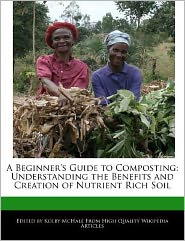
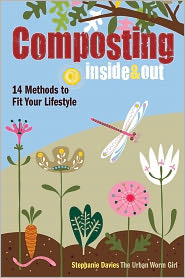
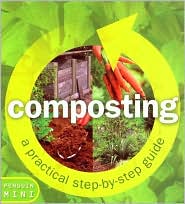
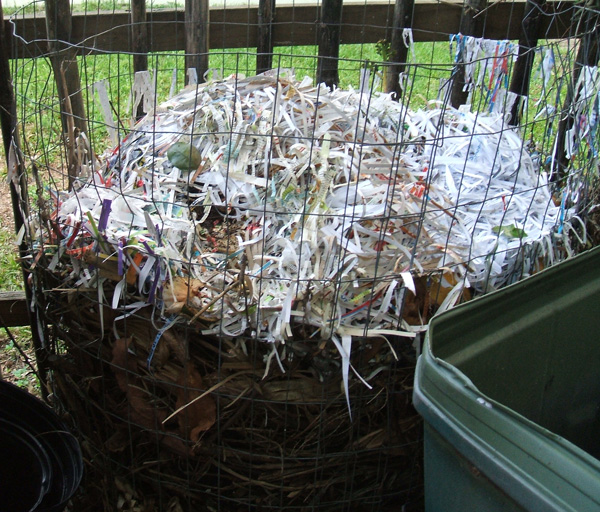 I started adding twigs and small tree limbs to the compost pile, breaking them
up into smaller pieces to speed the process. Whenever I did any carpentry, I
tossed the scraps and sawdust on the pile, making sure there were no nails.
I kept a large jar in the kitchen where I collected fruit and vegetable
peelings, coffee grounds including the paper filter, egg shells and anything
else that would eventually break down. I never added any dairy products,
fats, meat or fish because they draw unwanted critters like raccoons. Anyone
who gardens knows what pests raccoons can be, even without enticing them
with a midnight meal.
I started adding twigs and small tree limbs to the compost pile, breaking them
up into smaller pieces to speed the process. Whenever I did any carpentry, I
tossed the scraps and sawdust on the pile, making sure there were no nails.
I kept a large jar in the kitchen where I collected fruit and vegetable
peelings, coffee grounds including the paper filter, egg shells and anything
else that would eventually break down. I never added any dairy products,
fats, meat or fish because they draw unwanted critters like raccoons. Anyone
who gardens knows what pests raccoons can be, even without enticing them
with a midnight meal. 